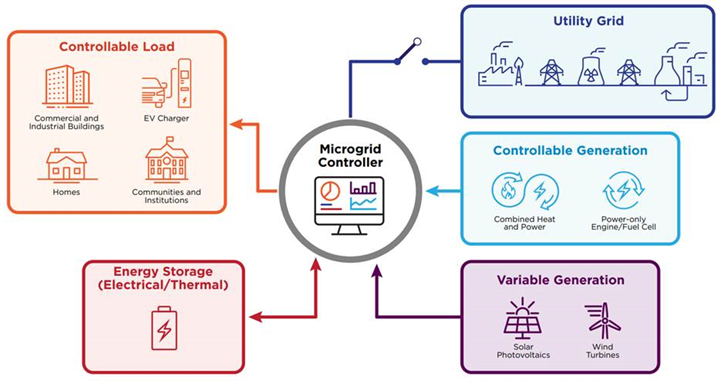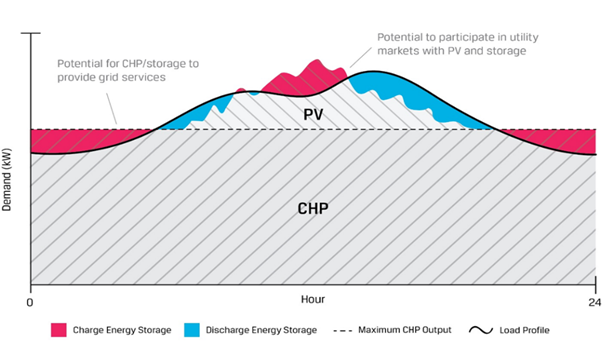CHP's Role Providing Reliability and Resiliency
On this page:
- CHP’s role providing energy reliability
- CHP’s role providing energy resiliency
- CHP's role in microgrids
- Additional resources
Unreliable electricity service represents a quantifiable financial, safety, and public health risk for companies, organizations, governments, and individuals.
CHP is an on-site generation resource that can produce electricity and thermal energy 24 hours a day. It can also be designed to operate independently from the electric grid. Because of this, CHP continues to play a valuable role in providing energy reliability and resilience for utilities, businesses, and organizations while also allowing end-users to save on energy costs and reduce greenhouse gas (GHG) emissions.
As efforts continue to decarbonize the energy sector, cleaner options that can provide energy reliability and resiliency will increasingly become available, e.g., long-term energy storage paired with renewable generation. CHP’s continued role providing reliability and resiliency will evolve based on the adoption of these alternatives; the degree to which electrification of heating in the commercial, industrial, and residential sectors takes place; and CHP’s ability to use renewable fuels. At the same time, some CHP technology options, such as fuel cells, can remain a cost-competitive, low-carbon option.
CHP’s Role Providing Energy Reliability
CHP systems are available almost 98 percent of the time to provide facilities with continuous electricity and thermal energy (only needing to be taken offline for routine maintenance). CHP systems can also be designed to operate independently from the grid. By providing electric and thermal energy to facilities on a continuous basis with the ability to operate independent of the grid, CHP can provide critical power reliability for many businesses and organizations. As a distributed resource, CHP also puts less load on the grid—which means CHP also enhances grid stability and relieves grid congestion.
CHP Systems Can Replace Backup Generators
Risks associated with unreliable energy supply often compel customers to install backup or emergency diesel generator sets, tying up significant capital in infrequently used assets that need periodic maintenance, costly refueling, and frequent testing. CHP, when implemented with black start capability, can be a reliable and cost-effective alternative to installing backup generators by providing protection against extended grid outages.
CHP’s Role Providing Energy Resiliency
CHP contributes to energy resiliency because of its ability to operate independently of the electric grid. If designed with black start capability, CHP systems can maintain energy supply to facilities during grid outages.
Over the past decade, CHP has proven to be a resilient energy solution for many facilities across the United States (pdf), allowing them to remain operational and provide critical services during extreme weather events and extended grid outages. For example:
- The Texas Medical Center in Houston, which houses a 48 MW CHP system, operated without interruption during the days Hurricane Harvey struck the region in 2017.
- In New York City and throughout the Northeast, multiple facilities used their CHP systems to keep the lights on when Superstorm Sandy hit the area in 2012

The U.S. Marine Corps Recruit Depot in Parris Island, South Carolina, trains about 17,000 new recruits every year. To meet Department of Defense and Navy policies for resilient energy, a 3.5 MW CHP system was installed on the 8,000-acre depot in 2019 to support a microgrid that also incorporates 5.5 MW of solar photovoltaics and a 4 MW battery. The hybrid microgrid meets all the depot’s thermal requirements and nearly all its electricity demands.
Image courtesy of Business Wire. For more information, visit https://chptap.ornl.gov/profile/121/MCRDParrisIsland-Project_Profile.pdf.
CHP's Role in Microgrids
Microgrids consist of connected loads and energy resources that can operate independently of the local utility grid. CHP plays an important role in supporting the energy reliability and resiliency of many microgrids by providing baseload power and heat to connected buildings. According to the U.S. Department of Energy's Microgrid Installation Database, over 200 microgrids in the United States incorporate CHP, constituting about 35 percent of all microgrids and representing nearly 2.4 GW of capacity. Microgrids with CHP support campuses, communities, and large buildings.
The diagram below shows how CHP and other resources, including energy storage, can serve loads both connected to and disconnected from the utility grid through a central microgrid controller.
CHP Can Be an Important Resource in Microgrids

Why CHP Is a Valuable Microgrid Resource
CHP can be a key resource to use in a microgrid because it provides a reliable, continuous, and controllable baseload source of electricity and localized thermal energy. Until energy storage allows renewable energy sources to be cost-effectively and reliably available on a continuous basis, CHP will continue to be a valuable resource, allowing renewables to serve peak daytime loads and support utility grid operations.

CHP can enable microgrids to extend beyond just electrical reliability and resiliency. The heat produced by CHP can be incorporated into a district energy system, ensuring a campus has total energy reliability and resiliency during an outage.
North Carolina State University operates two CHP utility plants together in a microgrid. In addition to electric reliability, the campus is able to produce 160,000 pounds of steam per hour and incorporate a 2,000-ton steam turbine chiller in a district energy system to meet its heating and cooling loads.
Image courtesy of NCSU. For more information, visit https://chptap.ornl.gov/profile/168/NCSU_CHP-Project_Profile.pdf.
The figure below shows an example microgrid system consisting of CHP, solar photovoltaics (PV), and energy storage. This combination of resources creates a flexible, independent system that ensures facility energy reliability 24/7 while providing additional benefits. In microgrids like this example, CHP systems can use excess electricity production to charge batteries that would then be used to meet morning facility demands before the solar PV ramps up during the day. Excess solar PV electricity can either be routed into batteries to be consumed later or be used to provide grid services and participate in utility markets.
CHP + PV + Storage Microgrid

Source: DOE, Combined Heat and Power Technology Fact Sheet Series: Microgrids (pdf), February 2021
Additional Resources
- CHP for Resiliency Accelerator. Led by the U.S. Department of Energy (DOE), this program supported the use of CHP as a resilient power solution for critical infrastructure through the development of a planning guide, a screening tool, and other resources.
- REopt Lite Tool. Developed by the National Renewable Energy Laboratory, this tool allows users to evaluate the economic viability of distributed energy technologies including solar PV, wind, battery storage, and CHP. The tool identifies economical system sizes and dispatch strategies for different combinations of technologies that can sustain operation of critical loads during grid outages. For facilities with substantial thermal energy requirements, CHP can provide an economic and highly resilient option.
- Combined Heat and Power: Enabling Resilient Energy Infrastructure for Critical Facilities. (pdf) Developed by Oak Ridge National Laboratory, this report provides case studies of facilities that continued operation during grid outages because of CHP, information on the design and use of CHP for reliability and resiliency purposes, and key state and local policies designed to promote CHP in critical infrastructure applications.
- Guide to Using Combined Heat and Power for Enhancing Reliability and Resiliency in Buildings. (pdf) Created by EPA and DOE, this report provides an overview of CHP and examples of how it can help improve the resilience and reliability of key infrastructure.
- Combined Heat and Power Technology Fact Sheet Series: Microgrids. (pdf) A DOE resource, this fact sheet provides an overview of microgrids and CHP’s role in supporting microgrids.
